Dance For Wellbeing is Dance For Everybody- A Q&A with Philip Piggin
In 2001, a collaboration between the Mark Morris Dance Group and The Brooklyn Parkinson Group resulted in Dance for Parkinson’s.
This program has since inspired a global wellbeing movement, even taking hold here in Canberra.
For people living with Parkinson’s, dance has a plethora of benefits, with its mental, physical and social engagement opportunities.
Philip Piggin, a true ‘animateur’, has been crucial to the implementation of the Dance for Wellbeing program in Tuggeranong and Belconnen. Classes here are tailored for people with Parkinson’s, Dementia, and everybody keen to join in on the fun.
I was fortunate to speak with Philip about the legacy of dance in his own life, as well as in those of the participants of the classes.
Ruby: You have quite a background in dance- would you be able to tell me a bit about that?
Philip: Sure. I guess as a child I found dance was always good fun…bopping away with all of that fabulous music from the 60s and 70s.
Then, I wandered off to Sydney to train to be a secondary teacher…about my second or third year of teaching I was informed of a dance/drama group based in Sydney- I was teaching in the country by then. These people had been involved in this group, which was called the Margaret Barr dance drama group, and Margaret Barr was quite a significant, early modern dance artist here in Australia.
So I came back to Sydney and decided I wanted to be a dancer at the age of 24. Ridiculous, ridiculous, really- but when the passion drives you!
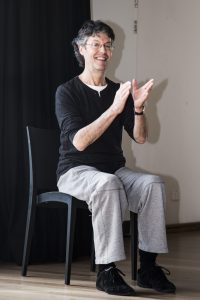
After some years of training part-time and then full time at the VCA, I was lucky enough to be accepted into The Contemporary Dance Company, based in Sydney and directed by Karen Kerkhoven. I learnt heaps, and am indebted to her for providing me with this amazing opportunity.
We did a lot of work in schools around NSW and the ACT, then I had the opportunity to travel over to the UK with my Mum, we’ve got English ancestry… so, took off to London to the UK and Europe, and then toured around for a couple of, about six weeks with Mum, then Mum came back and I stayed on and started to get a big picture of what this dance world was.
One thing I became aware of was this notion of community dance…there was really excellent dance practice for little kids, and young people, and adults, and people with disabilities, and seniors, and it was in fact an incredibly rich, and valuable, and important art form that had so much health and wellbeing attached to it. And that’s what I think particularly engaged me…my heart and soul became very invested in making dance something that was there for everybody.
At the time it was the late 80s and the UK is, I think, one of the leading exponents of community practice about the arts being there for everybody, not just professional artists but something that has great benefits to the community at large, so they certainly invested significantly in what they called dance ‘animateurs’ in every county across the county in the UK, and an ‘animateur’ is a French word meaning, sort of, an activist, or someone that breathes life into something.”
And after about ten years in the UK I think I’d had enough of the weather, primarily and but also I was missing family and and and things were changing there and I thought maybe this was the time go back home to see if I could bring this passion and the skills that I’d learnt…And came back in 93-94, and then worked in the regions for about five years developing quite a range of different community dance projects, actually performed projects at some schools and workshop programs, and came to Canberra in 99 and started work here at the art centre in 2010.
I guess being aware of that very ethos, that we were about dance for everybody here, we set up a number of programs across all the art forms…Then in 2013, I became aware of this Parkinson’s dance program and we did the two days training in Sydney, and came back, talked to Parkinson’s ACT– the Parkinson’s agency that oversees programs for people with Parkinson’s- they were really keen to get the program started.
I was lucky enough to get a Churchill Fellowship to go and spend three months in traveling overseas…dance programs for people with dementia in the UK and the US, and again very enriching, rewarding experience.
And I came back and said to my colleagues ‘this is what i’ve learned about, this is what we need to do here’, and we were incredibly lucky- wrote up a big application to ACT health for a 3 year program to really develop dance programs for people with Parkinson’s and dementia and and a mix of other challenges. We were lucky enough to get that, and so ran that for 17, 18, 19, and that was…a very wonderful experience. And in partnership with Parkinson’s ACT, and also Dementia ACT, as well.
View this post on Instagram
Ruby: Your experience is fantastic and I think that is part of the benefit of the program: it’s taught by people that have the whole background of knowledge so they can really understand dance and what it does for the body. You were talking about it (dance) being in the mind as well as the body, could you tell me how that really helps people with Parkinson’s or Dementia?
Philip: Sure. I guess the fact that dancers are people that know how the body is, how it functions, how it moves- that provides such a solid base of information…one of the major impacts of Parkinson’s is blockages to their neural pathways that really compromise their movement patterns and abilities, and dancers are somewhat experts at moving because that’s our profession, thats what we do, and particularly for people with Parkinson’s, if it is then presented as a task with music, it’s the provision of that regular rhythmic beat that somehow helps their system bypass the blockages that can make them quite tentative and have the stop-start and blockages.
Because somehow or other, connecting with that music and that beat is what keeps them going and establishing a much more flowing, coordinated control of movement.
Some of it’s still a bit mysterious…a lot of good music from the 60s and 70s is very poppy, happy stuff, and I think a program that touches on those things that have been such a big part of peoples lives has had many, many fascinating outcomes…there’s certainly a growing body of research to validate the very important role that dance plays- physically, cognitively and socially.”
What has been extraordinary to observe is even as people have lost their language and vocabulary, as demential progresses, put on a song they know from their younger life- they can sing it word perfect.
Music and the words of those songs are one of those things that remain for such a long, long time within the brain… in the dance class, put on the Beatles or the rolling stones or whatever, and they’re just singing it word perfect. It’s quite a fascinating thing.
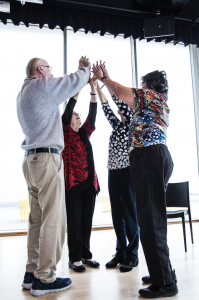
Ruby: That’s fantastic. Have you had any enquiries of people wanting to base some research on what’s happening here in Canberra?
Philip: Interestingly, yes, we’re actually working with some people at UC who are doing some research- they’ve interviewed a number of the dancers and I think that’s in the process of being written up and pulling some research findings from it.
At the end of the three year project with ACT health I also had to submit quite a big report about it and also we were taking surveys all the way through just asking people kind of every three months to record how they were feeling as a result of the program, how was it impacting upon their thinking, and their social connections, and their physical wellbeing.
And the response certainly, absolutely, validated that…they really felt they were part of a community that kept their spirits up, they felt their brain was having a good workout in the process.
They were maintaining, if not improving, some of the physical indicators as well, which for people with what is a degenerative condition, if they felt they were maintaining their mobility, then that is fantastic.
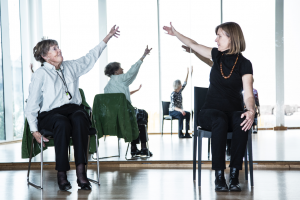
Ruby: You were talking about confidence- I feel that would be something that really impacts peoples lives more than you might think on the surface level
Philip: Yes…I guess, as people, we like to feel we are in control of our bodies and have that grace in whichever way we interpret that word…and interestingly, the confidence thing is really important as well, as people grow older. You know, if you’re a little one you’re falling all the time, but that’s fine because it’s only the ground, it doesn’t hurt! But obviously as you progress and become older, it becomes a real issue with seniors, and particularly that confidence about not falling…and if we can keep people confident that they can maintain their balance and their stability, they can continue living their life as they’ve always done.
That becomes quite a powerful tool of self empowerment, and as you’ll see in the class, we always generally run in a circle of chairs so there’s a lovely equity about the program. Class always starts seated and then after about a third to half of that time, we progress to standing, holding on to the chairs, so that’s got a bit of confidence there for people…it’s that progression that just gently, gently ensures that people continue to maintain their stability, their balance and thus a quality of life.
I guess If you come from an OT or Physio background there’s so many crossovers between what happens in that, I guess, more medical side, and what happens in the dance world. You know, we do a lot of that stuff, we just do it with music and perhaps laugh a lot more.
View this post on Instagram
Ruby: What would you say to somebody that was unsure about coming to try a class?
Philip: Come and give it a go, what have you got to lose, you know?
I always say to people who enquire and say ‘can I just come and watch the class?’ And I say ‘that’s gonna be like going to a restaurant and looking at the food, is that going to give you an idea of what it’s all about?’ Of course not, you’ve gotta just jump in and try it.
And nobody’s watching you, or marking you, or assessing you…people are invited to do the class to the best of their ability on the day. Because people come in feeling, and functioning, at quite different levels depending on where they’re at with their various conditions, where they are at with their medication, so we’re just inviting people to do the best they can with the body that they bring today, and have fun, enjoy it…we’re pretty sure it’s going to be a positive experience. That’s certainly the feedback that we get, so everybody’s welcome to come and give it a go, absolutely.
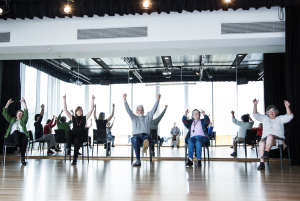
Ruby: Do you encourage people to also do similar stuff at home, or is it better when it’s in a supervised environment, where there’s other people?
Philip: Look, good question, we certainly encourage people to do…regular exercise. I mean, as humans beings we’re encouraged to do at least half an hour of exercise every day, and we certainly do encourage all our participants to be doing the same…
But we really encourage a diverse range of physical activities. Like anybody, it’s important to do the walking stuff, the dancing/coordination stuff, but also the weight resistance stuff. And it’s that whole suite of different activities that’s really important, in fact, UC- the physio department there I think run a whole program of exercises particularly for people with Parkinson’s.

Ruby: You mentioned earlier that the general participant age range is usually 50 and above, have you had people younger than that?
Philip: Younger onset ones? Good question, not really, I think because the onset of these conditions does tend to be in that fifty plus age group, and I think what’s also quite hard for people when they are first diagnosed with a condition is, understandably, a reluctance to see where they’re going to be later on with the onset of that condition.
And, I guess, that’s a bit of a challenge- to let people know… that that’s the reality. Although, there’s always new drug trials going on and research going on to try and address it, so people often may tend to come once they’re a bit progressed with the condition…whats really proven is that it’s so important to get onto a regular…rigorous exercise program to maintain your health and wellbeing for as long as you can.
And, you know…I suppose one of the most challenging aspects of the program that I’d certainly not really thought of, having mostly worked with, you know, younger people, or mostly adults, is inevitably with this program we lose people… one of the sad things is having to then go to the funerals with those people with whom we’ve developed quite close relationships with over the time. So it’s certainly been a growing experience, learning much in the journey, but I feel always so privileged that the people have had this time with us, and we’ve got to know these extraordinary human beings that bring a lifetime of incredible experiences with them.
Ruby: That’s right, and I’m sure they would be happy to have spent some time in this community.
Philip: Exactly, and one of the wonderful additional activities that we had as part of the program, is at the end of each term, we’d have a combined afternoon tea or lunch or something just to celebrate the terms achievement. So that was a lovely opportunity for just shared fun, and discussion, and eating, and drinking.
We also had complimentary tickets to Musica Viva concerts which was absolutely wonderful, so we appreciated that chance have a bit of a social outing all together. And the Canberra Theatre Centre also would offer us twenty or so complimentary tickets to see various dance performances and theatre performances that came through, so those sorts of things really enriched, I guess, the social connections that we made, and additionally just opened peoples eyes often to the rich diversity of dance practice and the wonderful music offerings that existed in the world as well. so it became a very full and rich program…
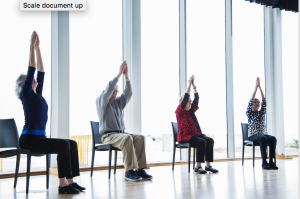
Ruby: Definitely. I did notice that there was a video for a public performance from the Dance For Parkinson’s group; ‘I used to run Marathons’, is that a thing you do frequently, or is that a special one-off experience?
Philip: Good question, I guess performance is often associated with the performing arts and I have to say when we started the group I had no heavy expectations that we would be performing.
I thought, let’s just gather the groups and let them settle and find out where we’re all at and then, come the time if performance opportunities come up, we’d ask them.
And it’s always the group’s decision. And, inevitably, invitations came up. And so the performance ‘I used to run marathons’ came out of a big project that Canberra Dance Theatre was doing called ‘Great Sport’. It was funded by ACT sport, so the theme was about the engagement with sport, and in fact that title came out from one of the dancers in the Parkinson’s group…he was telling me what he did as a younger person and ‘I used to run marathons’. I was like, ‘this is what we’re about’.
And so I worked with the leader of the group in Tuggeranong and together we kind of brainstormed the idea and found that very moving music, and of course, asked the group if they would be happy to do it, and they’d been dancing together for a couple of years and so I felt they were ready for a bigger performance.
And look, we had actually had some littler performances since then, in fact, just on Sunday (May 2nd) was the world Parkinson’s day event and that was probably the first one that we performed at in 2014, because they felt we were invited by the Parkinson’s group, and they felt they were safe there within their community, and people would understand.
So, it probably started that journey of performance- never the only only outcome of the program, but it was like a fringe benefit, if you like. But it was a wonderful to see people grow then in their self esteem and confidence. That performance is about the elite Australian ballet at the Sydney Opera house, but it’s also about a whole lot of other performance experiences, and they have become very confident, and assured, and strident that yeah, dance is for everybody and this is us doing our thing.
And okay, we might have a few wobbles and the shakes, but we’re here doing our thing and please enjoy.
And it’s been a wonderful additional dimension to the program. And we’ve toured interstate, in fact, to Majors Creek Festival…and we also performed a couple of years ago at the Dance Science Conference at the Riverside Theatre in Parramatta…we performed ‘I used to run marathons’ there and yes, to a standing ovation at the end it was a very, very moving and inspiring event. So that certainly has been another absolute slab of icing on the cake.
See an excerpt of ‘I used to run Marathons’ below:
Ruby: Everything you’ve said just then really sounds- especially when you mention that people sort of grow in their confidence and really do believe that dance is for all- that sounds exactly like you’ve fulfilled what is being set out to be done.
Philip: Exactly, exactly.
Ruby: Is there anything you’d like to add?
Philip: Look, I think it’s been an exemplary indicator of the power of the arts and the power the arts can play in the health and wellbeing of human society. As perhaps a lot of the individual face to face personal connections that we have in life may be increasingly compromised through not only world pandemics but devices which play sort of a duel role, they enable connections but they also facilitate a lot of connections that perhaps are of a variable quality.
And, you know, really concerning to hear that some of the loneliest people now in society are people in their twenties, and that to me was a shocking bit of news, that I suppose is just a reflection of where society is at in many ways that people, young people, spend a lot of time on their devices,
and to me, dance, that engagement in the art form is such a wonderful way to validate the absolute essential importance of social connections, and physical workout and the solid workout for the brain.
I was invited to join a Dance for Parkinson’s class after speaking with Philip, and was blown away by the enthusiasm and energy of the participants.
The power of dance and its benefits for the mind, body and soul were evident and inspiring, as were the tutors, Jacquie and Amy.
Volunteer at the Dance for Wellbeing program, Diana Sandeman, shared her own observations throughout her involvement in the program,
‘Well, as a volunteer, I’ve been coming for a few years and I’ve noticed a lot of people who arrive in a condition where they need help to go to their chairs, and they have to have somebody holding their arm to walk into the room, but by the end of the class, they’re able to walk unaided and even join in a circle dance at the centre of the room, and they look a lot more alert, and their eyes are brighter, and they’re able to converse better, as well.’
Research into the effect of the Canberra Dance for Wellbeing program has been extraordinary, the ACT Health report sharing that,
‘Affirmingly 93% of respondents reported an improvement or significant improvement to their overall feeling of wellbeing, and 85% reported an improvement or significant improvement to their social connectedness.’
So with that in mind, it may be time to put on your records and step into the world of dance, you never know how good it could be for you.
Take a look at a ‘Dance for Parkinson’s performance from 2018, below:
Note: questions and answers have been edited for length and/or clarity.
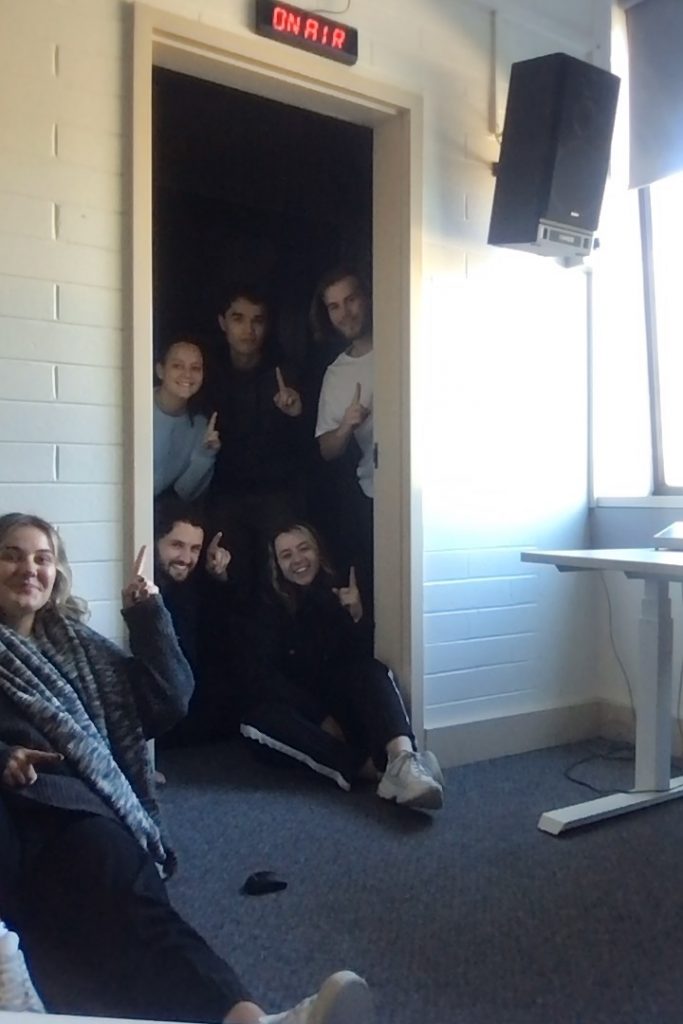
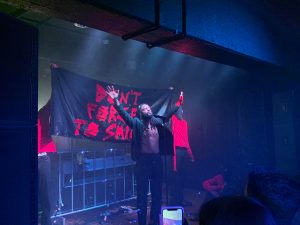
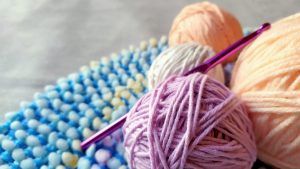
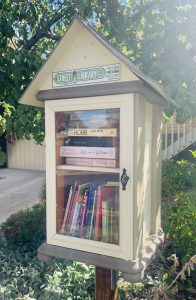
Be the first to comment!